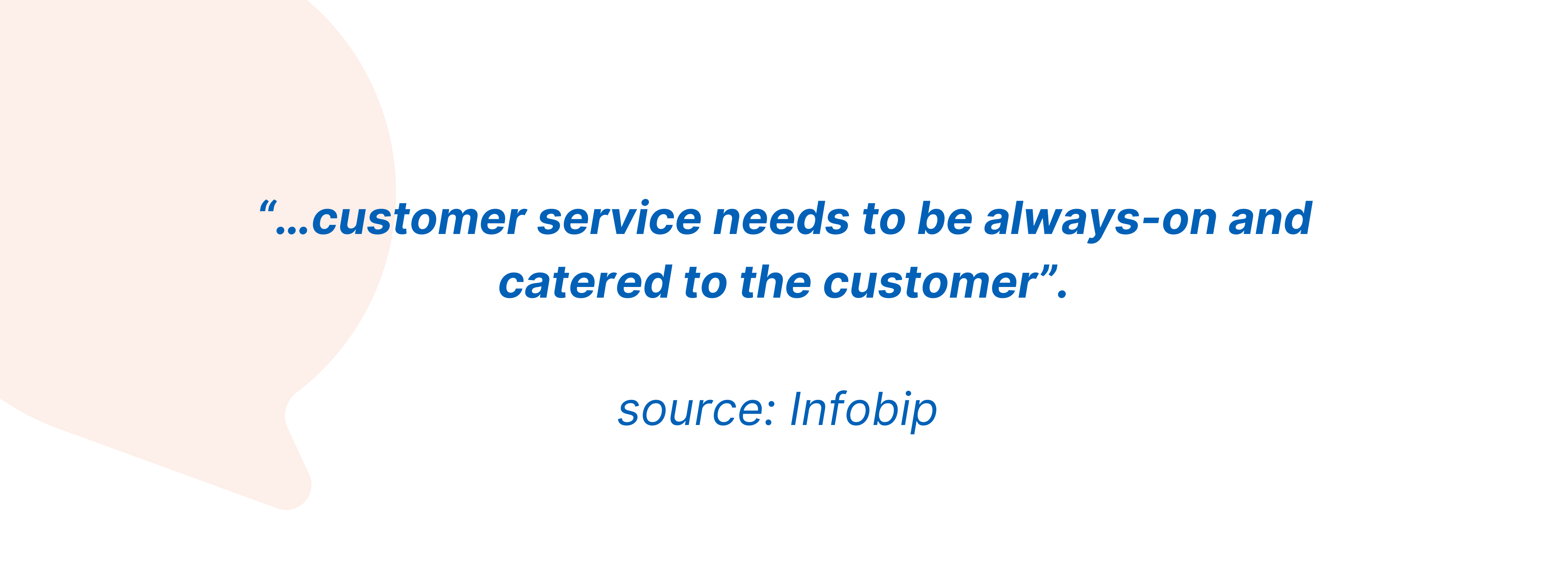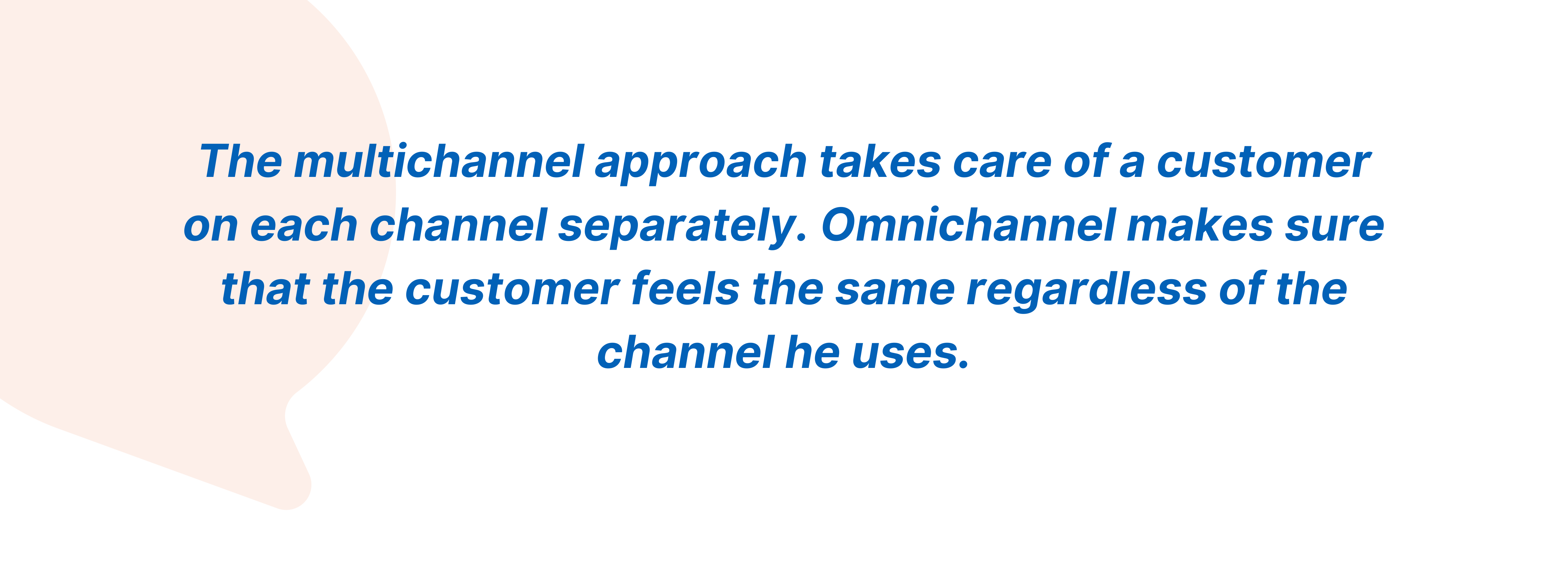Two, at first, almost identical, types of communication between companies and customers with multiple channels have one significant difference - integration.
What once was a simple, straightforward B2C communication, with the rise of the digital world and all its assets, got a bit complicated. That business to customer relationship shifted from a simple process of supply and demand to the creation of emotional connection and brand loyalty.
What makes the difference is the answer to the question - how do they manage the channels. Is there a smooth integration between all the channels or is every channel managed on its own?
It all comes to a single goal - better customer experience, something that is impossible to get if the customer journey isn’t perfectly connected with company services.
Omnichannel communication is manifested through multiple channels, in a seamless process for the customer. It is a consistent customer experience through the whole customer lifecycle - from initial pre-sales contact to post-sales relationship nurture.
With this type of communication, companies build a standard approach. “The messaging, advertising methods and purchasing experience will also be the same because the omnichannel approach creates a cohesive, unified experience.”
No customer has the same journey or the same initial approach to a company or a product. Some may go straight to customer service, some try to contact a company on Facebook, and some might look for the information on the website.
The other side, the company, needs to be ready to answer that inquiry at any step of the process.
Infobip, a global leader in omnichannel communication, points out three main benefits of holistic omnichannel experience: engagement, satisfaction, and optimization.
1. Maximize customer engagement
The better a company knows their customers, the better it can answer their needs. All the channels running are not just for one way communication. Using its full potential, a company can adapt its approach to each customer. Not only to sell a product but also to get to know customers.
Creating customer profiles, gathering information about their desires, wishes, habits, and pet peeves; helps companies build and grow a strong customer engagement.
2. Improve customer satisfaction
Satisfaction comes from fast and efficient problem-solving results. Having a plethora of channels makes the company approachable, but having bad or no connection between them, makes the company unreliable.
Let's say that a customer contacted you via customer support about an issue he is having. Your reply and fix it. In about a week, a customer has the same issue and contacts you on Facebook. He expects you already to know what he is talking about, regardless of how he reached out to you and who is behind the company profiles. If you don't, that is a bad CX.

3. Optimize internal processes
To make everything run smoothly on the company side and save time both for customers and companies, chatbot comes as an easy and cost-efficient option.
To learn more about what benefits chatbots bring to your business, check this article.
If your company is using Atlassian products, check OmniChat for Jira Service Management. It is a cross-channel support for customers, on a single interface for agents.
Multichannel communication focuses on each of the channels individually and builds a strategy for them separately. Whether that be print, SMS or a chat app of the same company, it has its own approach.
Multichannel communication serves customers where they are, creating strong relationships around a single channel.
As defined by Emrasys: “Multichannel marketing is the implementation of a single strategy across multiple channels or platforms, thus maximizing opportunities to interact with prospective customers. A channel might be email, a print ad, a retail location, a website, a promotional event, a mobile app, SMS messaging, a product’s package, or word-of-mouth.”
1. More data
Companies can leverage the bond that customers have with one of the channels by gathering more information about them and creating more personalized relationships. Communicating with the same group of customers on a single channel allows a company the opportunity to get to know them better, to be more familiar with their preferences and habits.
2. Better reach
Implementing a multichannel communication strategy increases the possibility of higher visibility, bigger customer reach, and, in the end, the potential for revenue generation. Just like omnichannel, multichannel communication also gives power to the customer. It gives them the option to choose a channel they preferer, how, when and where they will interact with a company.
Creating multiple sources of information makes it almost impossible for a customer not to notice you.
3. Consistency
Focusing on each channel separately, companies can build consistent communication with customers. Content is created around it and formatted to target a group that uses mainly that communication channel.
The customer knows what to expect from the company. He is used to their communication style, frequency and overall experience. The problem comes when a customer wants to switch to a different communication channel.
It is common and, lately, necessary for companies to have both online and offline presence. One part of them manages them individually. That is multichannel communication.
The other part creates a seamless brand voice for all the channels. That is omnichannel communication.
Working on a strategy based on every channel on its own has many advantages. You can use their maximum potential, play with monetization tricks and algorithms, researches. During that time, a company can create an in-depth customer profile to target each group differently. The way omnichannel steps in is by connecting all those information and making a unified communication process.

The process of developing from a “just-looking” person to a loyal customer takes time; that is why it is essential to pay attention to every step of that journey. If a customer jumps from email to WhatsApp and, in the end, a physical store, multichannel communication will lose him, while omnichannel will protect the customer.
Whether we talk about retail, marketing, eCommerce or any other field, the omnichannel approach puts customers at the centre.
A business strategy will be successful if it meets customers at multiple touchpoints across their journey, where the customer initiates and still makes it look and feel seamless. In the end, the best multichannel communication is omnichannel communication.